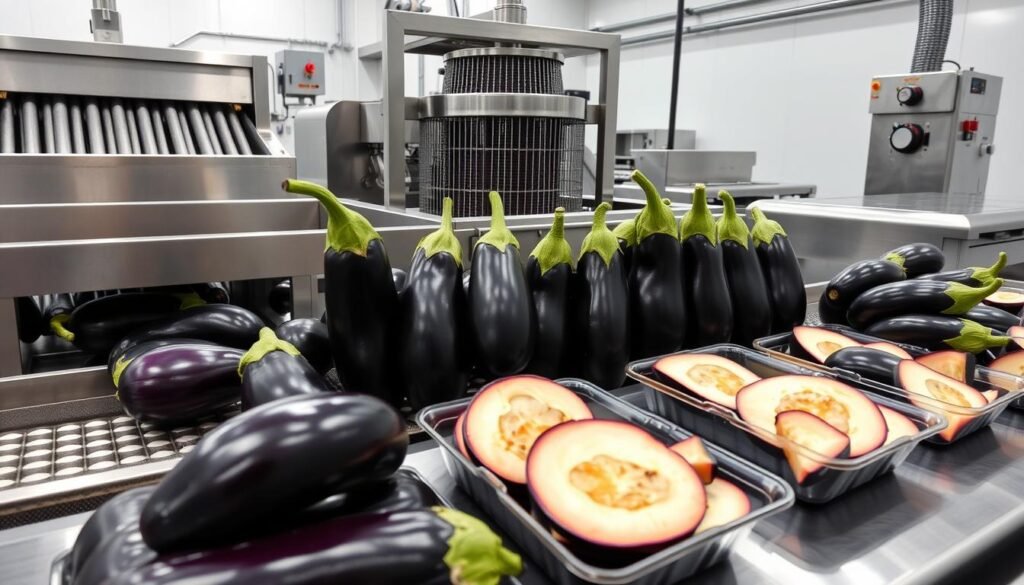Ever thought about how an eggplant turns into a gourmet treat? We’re diving into eggplant processing to find out. We’ll look at the techniques, the tools needed, and the new chances in the eggplant market. With more people eating plant-based, knowing how to process eggplants is key.
We’ll follow the eggplant’s journey from the farm to your plate. We’ll see the important tools, old methods, and new ways to make this market grow.
Key Takeaways
- Eggplants come in various types, with Chinese and Japanese varieties having firmer flesh compared to globe eggplants.
- Larger eggplants typically require more seasoning than their smaller counterparts, influencing culinary applications.
- Even cooking relies on proper oil application and cooking time, impacting the quality of cooked eggplant dishes.
- Techniques like scoring can enhance flavour absorption for value-added products in the food industry.
- Significant market opportunities exist for pre-seasoned and pureed eggplant products due to common culinary challenges.
- Extraction methods enhance the nutritional value of eggplants, spotlighting advancements in processing technologies.
Introduction to Eggplant Processing
The eggplant, known scientifically as Solanum melongena, has a long and fascinating history. It originated over 3000 years ago in ancient Asia. Today, it’s a staple in kitchens around the world, known as aubergine in many places.
History and Origin of Eggplant
The eggplant’s story started in South and East Asia around 50 BCE. It was first used for decoration, but soon became a key ingredient in cooking. Thomas Jefferson brought eggplant seeds to the US in the early 19th century, introducing it to a wider audience.
Over time, farmers bred different types of eggplants. Now, we have many varieties, each with its own taste and texture.
Varieties of Eggplant in the Global Market
Today, the global market offers a wide range of eggplant types. You can find:
- American
- Italian
- Japanese
- Diamond
- Blaukönigin
- Little Spooky
- White Egg
- Gilo Brazil
- African Egg
Each variety is suited for different dishes, making eggplants a favourite in kitchens everywhere. In the US, California’s Coachella Valley is a big producer of eggplants.
The demand for these eggplant varieties shows how much people love them. From its ancient beginnings to its modern-day popularity, the eggplant’s journey is truly inspiring.
Eggplant Processing Techniques
Learning about eggplant processing methods is key to making our food better and ensuring it’s of high quality. From washing to cooking, each step is important for our dishes. We’ll look at the main processes and the deep processing eggplant products available.
Overview of Eggplant Processing Methods
Eggplant processing includes washing, peeling, slicing, and cooking. These steps prepare the vegetable for eating. Different methods help keep its flavour and texture. Some notable methods are:
- Salting to remove extra moisture, making it less soggy when roasted or grilled.
- Dehydration to keep it fresh longer and deepen the flavour.
- Freezing for easy storage and keeping quality over time.
- Fermentation for unique flavours in dishes.
The method used often depends on the recipe and desired taste. Smaller eggplants are easier to season than big ones. Japanese eggplants, with their soft texture, can become custard-like with little effort.
Deep Processing Products from Eggplant
Deep processing eggplant is becoming more popular. It offers products that are convenient and healthy. Some popular products include:
- Eggplant puree: Great for soups, sauces, and spreads.
- Eggplant caviar: A tasty spread for dips or fancy toasts.
- Ready-to-cook meals: Perfect for those with no time to cook.
When making these products, it’s crucial to season them well. Eggplant can taste bland if not seasoned right. Proper seasoning makes eggplant dishes more appealing.

| Method | Description | Benefits |
|---|---|---|
| Salting | Draws out moisture from eggplant | Reduces sogginess, enhances texture |
| Dehydration | Removes moisture through heat | Increases shelf life and flavour |
| Freezing | Preserves eggplant at low temperatures | Maintains quality for extended periods |
| Fermentation | Uses bacteria for flavour enhancement | Creates unique flavour profiles |
Essential Equipment for Eggplant Processing
The right machinery is key to efficient eggplant processing. We have many options to choose from. This helps us make sure our production is both quality and consistent.
Important equipment includes machines that slice, dice, and blanch eggplant. These tools are crucial for handling large volumes of eggplant.
Types of Machinery Used in Eggplant Processing
There are several types of eggplant processing equipment. These machines help us meet our production goals. Here are some essential ones:
- Slicers – Essential for producing uniform slices, important for packaging and presentation.
- Dicers – Perfect for creating cubes or strips to suit various culinary applications.
- Blanchers – Used to enhance colour and texture, preserving the freshness of eggplants before further processing.
- Peelers – Streamline the peeling process, saving time and labour costs.
Recommended Equipment for Slicing Eggplant
We focus on high-performance slicing machinery for eggplant. These machines are known for their precision and efficiency. Here are some top recommendations:
| Machine | Type | Production Capacity (lbs/hour) | Slice Thickness |
|---|---|---|---|
| TranSlicer® 2520 Cutter | Slicing | Up to 2,500 | 1/4″ or 3/8″ |
| DiversaCut 2110A® Dicer | Dicing | Varies by motor power | 1/8″ to 3/4″ |
| Li An QD-320 Dicer | Dicing | Dependent on input size | 1/8″ to 1″ |
| Li An CT-212 Cutter | Slicing | 1,500 to 2,500 | Customisable |

Choosing top-quality slicing machinery for eggplant boosts yield and reduces waste. The Li An CT-212 Cutter, for instance, cuts slices quickly and precisely. This helps us meet high demand efficiently. Our production lines handle hundreds to thousands of pounds per hour, ensuring quality and safety.
Market Opportunities in Eggplant Processing
The eggplant processing sector is growing fast. This is because more people want healthy and easy-to-eat food. The demand for eggplant products that fit plant-based diets and quick meals is rising.
Current Market Trends and Consumer Demand
Health-conscious consumers are driving up demand for processed eggplant. Its versatility makes it a hit in many cuisines. In the Philippines, eggplant is the top vegetable, with huge production numbers.
This shows the eggplant market has a lot of room to grow. New processing and product ideas could unlock this potential.
Investment Potential in Eggplant Processing
Investing in eggplant processing is getting more appealing. Bt eggplant, with its health benefits and lower pesticide use, is a big success. It shows a move towards safer farming.
Farmers are making more money with Bt eggplant than with traditional ones. New breeding methods will make eggplant even better at fighting pests and weather changes. This makes the sector very profitable.
Businesses looking to get into eggplant processing should do their homework. They need to understand the market and what consumers want. Investing in eggplant processing is a smart move for those looking to grow their business.

| Key Factors | Details |
|---|---|
| Production Area (Philippines) | 20,000 hectares |
| Annual Production Volume | 179,000 metric tons |
| Health Cost Savings (Bt Eggplant) | P9.33 million yearly |
| Net Income from Bt Eggplant | P50,330 per P100,000 gross sales |
| Environmental Benefits | P2.27 million yearly for saved bird species |
Eggplant Processing: Techniques, Equipment, and Slicing
Learning how to slice eggplant right is key to bringing out its best taste and texture. As we explore eggplant processing, we find many ways to make tasty dishes. These methods also attract new people to the eggplant processing world.
Best Practices in Eggplant Slicing Techniques
Using the best eggplant slicing methods makes our dishes look and taste better. Here are some common ways to slice eggplant:
- Slices (ideal for grilling, frying, or roasting)
- Cubes (perfect for stews, curries, or stir-fries)
- Wedges (great for roasting or grilling)
- Planks or batons (used in recipes like eggplant parmesan)
- Rings (often used for making eggplant fritters)
- Hollowed out (for stuffing with various fillings)
Using a sharp knife, like the Nakiri knife from Dalstrong’s Valhalla Series, makes slicing easier. Its ergonomic handle helps avoid hand fatigue. The right tools, like the Lionswood Colossal Teak Cutting Board, keep our workspace clean and efficient.
Inviting New Entrepreneurs to the Eggplant Market
The eggplant market is open to new businesses. With more people interested in eggplant, new producers can find success. They can use effective slicing techniques and the right equipment.
By exploring different preparation methods and understanding eggplant’s unique qualities, newcomers can stand out. Using top-notch tools and following best practices helps build successful ventures.

| Slicing Method | Ideal Usage |
|---|---|
| Slices | Grilling, Frying, Roasting |
| Cubes | Stews, Curries, Stir-fries |
| Wedges | Roasting, Grilling |
| Planks/Batons | Eggplant Parmesan |
| Rings | Fritters |
| Hollowed Out | Stuffing |
Conclusion
Eggplant processing is full of chances, thanks to its rich history and many ways of preparation. It also needs better equipment to work well. The changes in eggplant during processing and the growing interest in eggplant products make it key in cooking.
Using new technologies, like those from Li An, can make things better. It helps us make products that people want. This way, we can enjoy eggplant in many different dishes.
Looking into eggplant processing shows it’s not just good for business. It also opens doors for new ideas and businesses in the food world. The future looks good, and our work with eggplant supports growth and care for the land.
FAQ
What are the main eggplant processing techniques?
Main techniques include washing, peeling, and slicing. Cooking, dehydration, freezing, and fermentation also play a role. They help keep the eggplant fresh and add flavour.
What types of equipment are essential for eggplant processing?
What types of products can be made through deep processing of eggplant?
Deep processing can create eggplant puree, caviar, and ready-to-cook meals. These products meet the demand for easy and healthy food.
How does the Li An Multifunction Vegetable Cutting Machine improve eggplant processing?
The Li An Machine offers precise slicing. This improves product presentation and reduces waste, keeping quality high.
What are the current market trends for processed eggplant?
There’s a big increase in demand for healthy, versatile, and easy-to-use food. This is especially true for plant-based diets.
What best practices should be followed when slicing eggplant?
Use sharp blades and keep pressure steady. Avoid bruising to keep the eggplant’s texture and taste good.
What opportunities exist for new entrepreneurs in eggplant processing?
New entrepreneurs have a great chance in eggplant processing. The market is growing for easy and plant-based foods. Doing market research can help find the best places to invest.
Source Links
- How to Cook Eggplant Perfectly, Every Time – https://www.bonappetit.com/story/how-to-cook-eggplant-perfectly-every-time?srsltid=AfmBOop6c2IKAr4OiVsD6fViNVHi1J07psN_eoHcj1K1zHzzW9OkLRfK
- Eggplant Peels as a Valuable Source of Anthocyanins: Extraction, Thermal Stability and Biological Activities – https://pmc.ncbi.nlm.nih.gov/articles/PMC8003047/
- Fryd – https://fryd.app/en/magazine/planting-eggplants-sowing-care-harvesting
- Eggplant in the Garden and the Kitchen – https://extension.psu.edu/eggplant-in-the-garden-and-the-kitchen
- How to Cook Eggplant Perfectly, Every Time – https://www.bonappetit.com/story/how-to-cook-eggplant-perfectly-every-time?srsltid=AfmBOooQ7WIq7b_y7aTGSu8_LMraVBCZhasKTdgV2jQphI5TJJS4IJyX
- How to Cut an Eggplant: 3 Ways to Cut an Eggplant – 2023 – https://foolproofliving.com/how-to-cut-eggplant/
- Industrial Cutting Applications For Eggplant – Urschel Laboratories – https://www.urschel.com/cutting-applications/eggplant/
- How to Cut Eggplant (with video) – https://itsavegworldafterall.com/how-to-cut-eggplant/
- The profitability of planting transgenic eggplants – SEARCA – https://www.searca.org/press/the-profitability-planting-transgenic-eggplants
- How to Cook Eggplant Perfectly, Every Time – https://www.bonappetit.com/story/how-to-cook-eggplant-perfectly-every-time?srsltid=AfmBOoqF385dMC4BQTMPvIo8J2kOTxiT9R68wa6OAkTfssJdBBIpIEQY
- Cut of the crop: High-yields of non-browning eggplant via genome editing – https://researchoutreach.org/articles/cut-crop-high-yields-non-browning-eggplant-genome-editing/
- How To Cut Eggplant In Different Ways – https://dalstrong.com/blogs/news/how-to-cut-eggplant-in-different-ways?srsltid=AfmBOorBipwm9_sJA-39Aol_YMWMW8RPpKx0CRwHP0qLHlnUMvj36QN8
- How to Cook Eggplant Perfectly, Every Time – https://www.bonappetit.com/story/how-to-cook-eggplant-perfectly-every-time?srsltid=AfmBOoqkdzXOxs4HVbGrSLqON0E9MyrWo02wy9wkt-3YK7p0Joa3vZxU
- Study on browning mechanism of fresh-cut eggplant (Solanum melongena L.) based on metabolomics, enzymatic assays and gene expression – https://pmc.ncbi.nlm.nih.gov/articles/PMC7994816/
- Redalyc.OPTIMIZATION OF VACUUM FRYING CONDITIONS OF EGGPLANT (Solanum melongena L.) SLICES BY RESPONSE SURFACE METHODOLOGY – https://www.redalyc.org/pdf/339/33953313009.pdf
- PDF – https://mjae.journals.ekb.eg/article_95567_f0508d3781da29b0cad1c87d6ed0d26b.pdf

